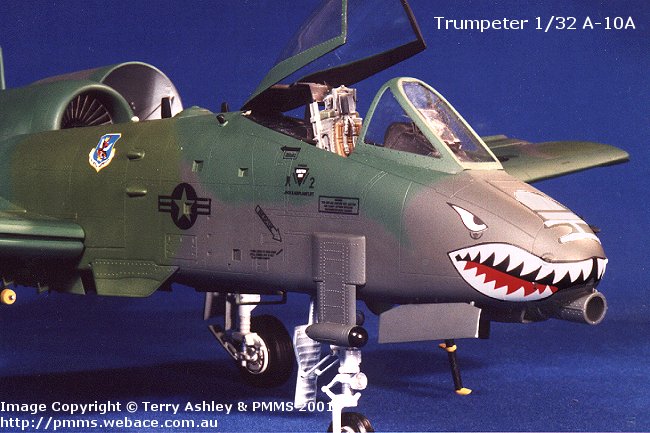|
A-10A "Warthog"
Trumpeter
Reviewed by Terry Ashley
Some may call it ugly, but the A-10 "Warthog" has appeal due to its uncompromising approach to the job at hand, its design and functionality. And don't forget that the jocks who fly the Hog do just that - "fly it" - unaided by sophisticated computers to get them out of trouble. Being on the wrong end of the GAU-8/A or its missile arsenal is not the place to be, as two helicopters and many hulks littering the Kuwaiti Desert will testify!
Trumpeter's 1/32 scale A-10A comes in a big box as you might imagine. The parts are tightly packed to fit them all in. There are 437 light grey parts on 23 sprues including 5 sprues of ordnance. The two engines are in resin with the undercarriage legs, boarding ladder and pitot tube in white metal. As with any white metal parts there are mould lines, which you need to lightly file off. The tires are in vinyl with nice tread pattern. 3 sprues of clear parts for the windscreen, canopy, Maverick and Pave Penny heads and the engine nacelle parts. A small length of twine for the wheel chocks and some metal parts (rearview mirrors) and hinge parts for the engine nacelles. Two decal sheets are included, one with the aircraft markings and the other with heaps of stencil data for the ordnance. (Although the printing on the stencils is a little blurred for this scale).
It is interesting that the strip lights, which were on the scans of the decal sheets we saw some time back, are not included on these sheets. The TwoBobs decal sheet for LASTE equipped Hogs includes these strips, so this is no real problem. Also in my sample kit is the additional decal sheet for the A-10A N/AW kit, I'm not sure if this will be in the A-10 kits that hit the shops. The moulding of the details on the parts is crisp with engraved panel lines and details as well as the raised rivet detail on the rear fuselage (as it should be). The rear fins also feature the right combination of flush rivets to the front and raised to the rear, very well done by Trumpeter here. The plastic is very soft which makes for easy cutting, but easy to cut too much when trimming parts, so take care. There is a small amount of flash around the edges of some of the larger parts which will require careful removal. The layout of the parts is conventional with fuselage halves, wings halves and rear stabilizers and fins in halves with separate control surfaces. The fuselage is split into rear and forward sections obviously for the two-hole N/AW version. The kit features the additional "bumps" for the LASTE (Low-Altitude Safety and Targeting Enhancement) on the fins and the GPS antenna dome on the fuselage spine. It should be noted that these are not fitted to Gulf War Hogs, so if you choose to model an A-10 from that period these will have to be removed from the kit parts. This is certainly better than having to add them, another tick for Trumpeter.
Please note that the kit is being built straight out of the box for use by the Distributor as a display model at trade shows. I will though note areas where additions or corrections can be included in the kit. One general comment here regarding the locating pins on some parts when mating two sides together (i.e. pylons, ordnance). A number of these were more a hindrance than help. A quick dry fit of each before gluing would identify any problems, I simply removed any pins that did not line up and then glued the parts direct. I used Tenax-7R throughout with no problems, except of course for the resin and metal bits where Cyanoacrylate was used.
Cockpit and Ejection Seat
The instrument panel is a decal that is too small to fit the panel coaming. Furthermore, the side consoles have very 'soft' details. There is no foot pedals and the control column is incorrect. It looks like they got the junior mould maker to do the cockpit while the masters did the rest.
The GAU-8A Avenger This is a very well detailed and straightforward assembly with 35 parts. The only real problem here is the ammo belts are given as lengths of shells only while they should be inside a metal wrap around feed belt. I suspect Eduard is working on this right now.
Care should be taken when assembling the ammo drum to ensure you put the drum the right way around on the lower support (part R17). Also remember to add the 80g weight inside the drum if you want your Hog to stand on it's own three feet. It's a pity this lovely assembly is completely hidden when installed inside the fuselage, you can of course display this outside the finished model. As only one muzzle is provided you will have to make a choice to install or show separate Note, the small base is a display stand made from plastic beam and card.
Forward Fuselage The surface detail is superb with nice engraved lines and all the intake and outlets moulded as separate pieces allowing the openings to be depicted open. The boarding ladder door is also separate and you get a white metal 'round profile' boarding ladder to fit here. The nose gear bay has nice details moulded on with plenty of room to add all that extra plumbing that lives in this bay. The refueling door is a separate part so as not to compromise the detail when joining the fuselage halves. The ALR-69 RWR antenna have their bases moulded into the fuselage halves with clear parts for the center 'bumps'.
The fit of the two fuselage halves was excellent with only minor seam cleanup needed. Unfortunately the cockpit assembly again provided problems. This hole assemble just seems out of context with the rest of the kit as I mentioned earlier and this extends to fitting it between the fuselage halves. The mounting lugs on the fuselage halves just didn't line up with those on the cockpit tub, I ended up removing the mounting lugs and positioning the tub manually for the best fit after many dry fittings. The instrument panel didn't match too well with the forward coaming either. Remember to add an extra 80g of weight anywhere inside the front fuselage as well as that inside the ammo drum. I choose to leave out the cannon assembly for display purposes, but dry fitting seemed to indicate no problems would be encountered. If you do this add the 80g of weight from the ammo drum in the fuselage where the drum would normally go. The lower wheel well section was then fitted in place, a bit of filler was needed on a couple of the corners but nothing excessive. The way they have engineered the air intake below the cannon as part of the wheel well assembly results in the correct opening when the sections are fitted together, very nice. Although there is a mounting pin lug just inside the opening which can be seen when assembled, it may be better to remove this lug before hand so it is clear through. Added to the fuselage is a number of separate intakes and antennas, ensuring these are cleaned up before fitting will see no problems. I left off the nose-boarding ladder and door until after painting.
Rear Fuselage, Stabiliser and Fin Assembly This again has excellent surface detail with the rivets changing from flush to raised from just behind the wing trailing edge as it should be. Again the RWR antennas are as per the forward fuselage. The horizontal stabilizers and vertical fins have separate control surfaces including separate trim tabs. These are also all designed to move and finally the rudder actuator rod is again a separate part for even more detail. The engine nacelle's are in six parts with separate doors to allow the engine details to be seen, these doors have fine metal hinges to allow them to operate. More on this in the engine section below. The join between the nacelle assembly and the rear fuselage will require a bit of work on the undersides, but the join between the nacelles and front cowling ring is spot on. Apart from the usual cleanup of the join line seams there were no problems here. The fit of all parts was excellent with the fit of the stabilizer unit to the rear fuselage being exceptionally good with no filler needed. I did add reinforcing strips between the forward halves of the rear fuselage (parts C3 & C4). This is because these fit over the lip of the front fuselage and I didn't want the seam 'popping' open if the fit was a little too snug.
Mating the Forward and Rear Fuselage One thing I noticed when fitting the front and rear fuselage sections to together was the lip on the front section tended to try and "force" open the rear halves. I removed half the depth of the lip and it fixed the problem still leaving enough overlap to ensure a good bond. The all important join between the front and rear fuselage sections sees the join between the overlapping trailing edge fairing (on the rear fuselage parts) to the forward fuselage sides spot on, as good as you will see anywhere. The top join will require a bit of filler but overall the edges match perfectly all around.
Undercarriage These are all solid metal castings and a good thing to as this is rather heavy model with the 160g of nose weight needed. The castings are good quality with the usual casting seems to be filed off, but nothing excessive. All the major fittings are provided, e.g. steering and landing lights on the nose leg. The large amount of plumbing on the legs will need to be added from various thickness of wire as none is provided. You are provided with screws to attach the wheel hubs to the legs, these proved to a royal pain in the butt. So much force was required to actually screw these into what is fairly solid metal resulted in two of the screw heads snapping off. It is far simpler to just Cyanoacrylate them to the axles.
The fitting of the legs to the locating holes in the nose and wings is very snug and would actually happily sit in place without and Cyanoacrylate being applied, but I'd still glue them. I did in fact leave the legs off until after final painting. The gear doors that attach to the main legs are a little on the thick side and could be reduced a far bit for a better appearance. There is also some nasty pin ejector marks on the inside of the gear doors that are difficult to remove owing to the detail on the doors.
Wings The wings are moulded in upper and lower halves with excellent surface details. The Fowler flaps are in separate upper and lower pieces (both inner and outer flaps) and designed to move in and out as per the rear aircraft. The instructions should be followed when installing the flaps and there shouldn't be any problems. The aileron/speed brakes are also in upper and lower halves and again designed to move, there is an inner bulkhead (spar) to fill the hole if you show these open. The inboard slats can also be positioned open or closed. The wingtip position light/strobe light is a separate clear part with excellent detail. The main gear fairings have no internal details apart from panel lines engraved on the lower wings that form the bottom of the bays. The real things have very little inside them apart from the fuel plumbing on the port side and some internal wiring. The fit of these fairings around the front ends is a mess. The top fairing on the starboard wing is the wrong shape, but the shape of the lower fairing (part M1) is OK, so you can use this as a guide to fill and reshape the upper part. The side joins forward of the leading edge doesn't match too well either and some filler will be needed here. The refueling panel on the port fairing is also the wrong shape, the break should be facing forward on a steeper angle with a small lip at the bottom and not straight across as in the kit. The wing fences inboard of the wheel fairing will need replacing, as they are the wrong shape, obviously a casualty of moulding restrictions. This all sounds like a lot of work, but overall the wing assembly has excellent details in the surface detail and shape. The rear chaff/flare dispensers are nicely detailed but appear to be slightly too narrow, but you have to be really picky to notice this on the finished kit as they are facing down. The side profile appears to be OK. The underwing pylons are each in two halves and "sit" in small recesses on the bottom wing, while the three fuselage pylons sit flush with the bottom fuselage and they each have sway braces as separate parts. The joins between upper and lower wings is good dimensionally, but again a little "soft" at the edges and will require some filler, especially the underside of the wingtips inside of the downward sweep. This join has been a problem on every A-10 kit I have seen (i.e. 1/48 Tamiya and Monogram).
TF-34 Engines and Nacelles
Ordnance Including in the kit are these items:
The Mavericks come with triple launch rails although there is an amendment in the instructions, which also show the single launch rail most commonly used on Deserts Storm Hogs. I couldn't find this part in my kit. Maybe, as it is a sample, the production kits will most likely include these extra parts. Included is two MERs but no TERs. Unfortunately the Hog doesn't use the MERs except for training sorties while the TERs are used operationally. This means TERs will have to be found elsewhere. The Ordnance in general is the poorest part of the kit with some of the details being on the basic side.
If you thought you were going to paint this monster in one evening forget it - this is a big job. I used Model Master Enamels #1713 FS34102, #1764 FS34092 and #1788 FS36081 and Humbrol enamels for the finer detail painting. One point to note before commencing painting is that the Euro 1 painted Hogs had different pattern cam schemes during their life. The same three colours were used but the pattern differed. The Hogs during Desert Storm had a different pattern than post DS Hogs with the later LASTE additions. The painting diagram in the kit instructions is basically for the DS aircraft but a little different from what is in most photographs. The instructions with the Monogram 1/48 Hog have a typical layout for the pre and DS A-10s. The colour cam scheme in the Squadron Signal Walkaround book (#5517, page 69) on the A-10 is for a post DS Hog before they were progressively repainted in the current two gray scheme. I choose to use the later Euro 1 scheme as the kit has the LASTE mods and information suggests the kit decals for EL 209 depict an aircraft that wasn't actually used during Desert Storm. It is best to check you references closely before deciding which scheme to use. After masking off the cockpit, engines and gear bays (a job in itself), I airbrushed the Medium Green (FS34102). This was the easy part as you can liberally apply the green without having to worry about adjoining colours. The Dark Green (FS34092) and Gray (FS36081) followed this. I actually painted the model in three sessions mainly due to the full wraparound scheme holding the model while painting became a problem, it was also a bit of fun airbrushing the cam around the engine nacelle area. Once completed and fully dry, I then glossed the areas to receive decals, which lets face it on a modern jet is most of it. You get a nice selection of stencils on the decal sheet (NO STEPS and lifting symbols plus the many data blocks on the forward fuselage).
These are extremely thin and well printed (except for the stencils on the ordnance, where some are just blobs meant to represent writing). A number of the decals are in multiple parts to overcome any colour registering problems. The unit insignia on the tail and fuselage have two and three decals respectively; this is a good idea as any misalignment is then your fault (sorry guys). The thinness of the decals means they react very well to decal setting solution and really suck down around the surface details. The way the shark mouth decal sucked down around the nose RWR antennas was stunning. It also means you have to be careful when sliding the decal from its backing sheet onto the model as it is very easy to destroy the decal.
These are some of the best decals I have seen as stock kit decals. They are light years ahead of the overly thick stuff we get in Tamiya and Hasegawa kits. Why the data blocks on the ordnance decals are such a mess is strange as the data blocks for the aircraft itself are all fully legible.
The instructions are well laid out and easy to follow. They also feature tables showing the different weapons configurations and detailed painting guides for all the ordnance. Four view drawings are given for the Euro 1 paint scheme along with FS numbers for the paints and locations of the stenciling provided. Additional side views drawings show the placement of the unit markings. These consist of two aircraft shown below. The hogs teeth on the NO machine are white and red on the decal sheet, but light brown in the illustration in the Squadron Signal A-10 walkaround book. I have included here scans of the Instruction Sheets. This hopefully will give you a better idea of the detail and layout of the kit. Photos of the painted model. Please note, as I mentioned ealier this model is built straight from the box for use at trade shows by the distributor. The model was required for one of these shows before I was able to finish the weathering of the model. When it is returned, hopefully in one piece I will complete the weathering and other minor bits and update the review with the pictures.
This is a sensational kit, but like any kit there are areas that need attention. You will need to use some old fashioned modelling skills in places. Despite some minor fit problems and a bit of flash about the place, it takes the points with some brilliant surface and other details and and will build into a stunning model. I have not compared the kit to any plans, never have, never will. I use the Mk.1 eyeball to check for errors. If you can't see something by comparing to reference photos then it's probably so small as not to worry about. I'll leave the rivet counting to those better qualified.
For another opinion on this excellent kit, check Steve Filak, Sr's review at Aircraft Resource Center. You will also find some excellent Walkaround photos of the A-10 in their Walkaround section. You will also find a good build review by Jack Mugan with plenty of pictures at Rollmodels.com NEWS: Black Box are to release a cockpit update set for this kit. It will include tub, floor, rear bulkhead, instrument panel/coaming, throttle, control stick, rudder pedals, turtle deck, ACES II, two-piece canopy actuator (like the BB 1/48 scale set), and insert below the two cutouts on the turtledeck. Release date, tentative early April. More news when known. Highly Recommended. Review Copyright © 2001 by Terry
Ashley and PMMS
|
|||||||||||||||||||||||||||||
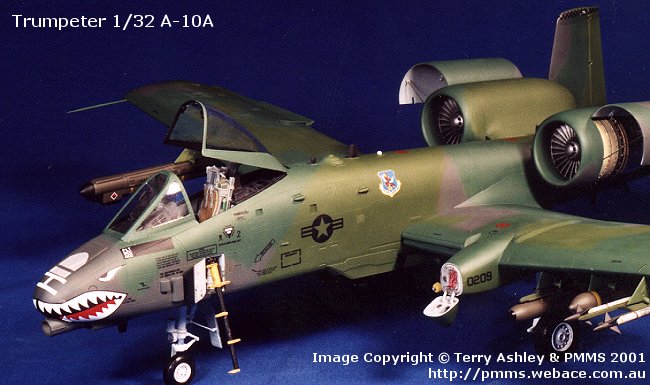

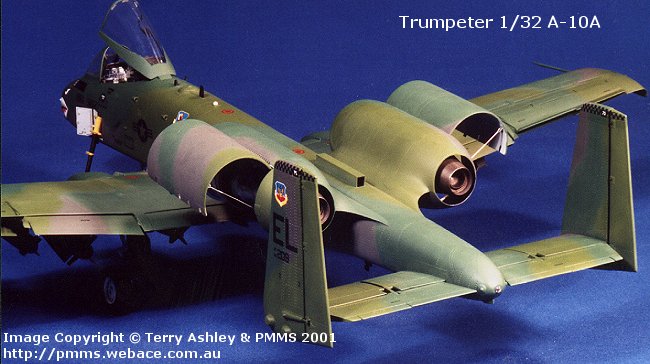

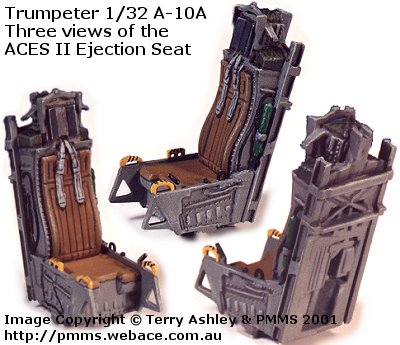 The
seat on the other hand is just the opposite and is one of the best seats I
have seen as standard in a kit for some time. It is made up of 7 pieces
with the oxygen bottle as a separate part and all that is needed is the
addition of the lap seat belts and with careful painting a very nice ACES
II will result.
The
seat on the other hand is just the opposite and is one of the best seats I
have seen as standard in a kit for some time. It is made up of 7 pieces
with the oxygen bottle as a separate part and all that is needed is the
addition of the lap seat belts and with careful painting a very nice ACES
II will result.

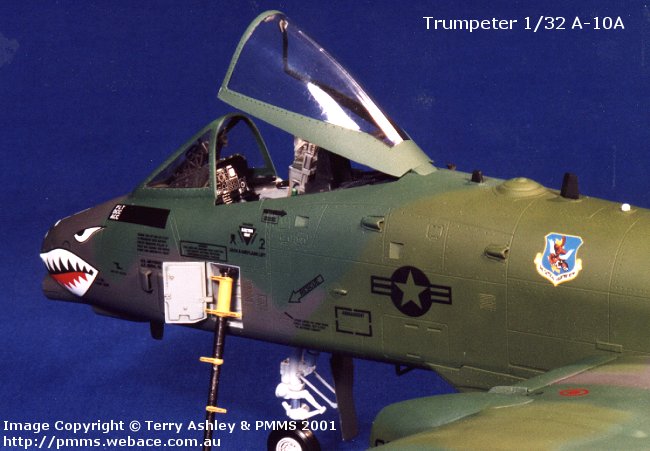
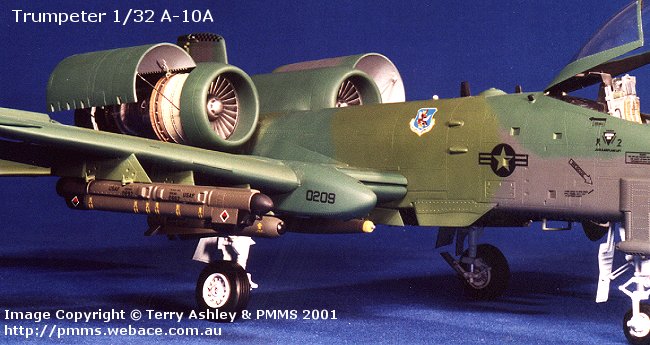
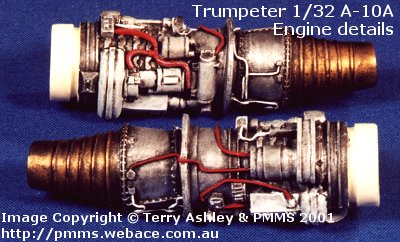 The
resin engines are excellent with nicely defined details. They include the
larger fuel lines and some other plumbing, but there is considerable scope
to add the myriad of smaller cabling that surrounds the real things. The
front turbine blades and engine surrounds are moulded clear, the blades
having gaps between them on the moulding.
The
resin engines are excellent with nicely defined details. They include the
larger fuel lines and some other plumbing, but there is considerable scope
to add the myriad of smaller cabling that surrounds the real things. The
front turbine blades and engine surrounds are moulded clear, the blades
having gaps between them on the moulding.
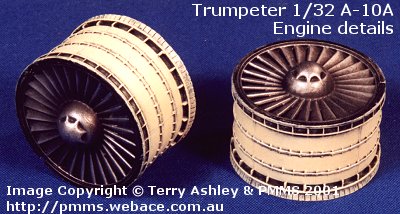 One
nice feature on the two clear cocoon parts are four stubs which when
fitting inside the front intakes ensure the engine is seated exactly
centrally, eliminating any lineup problems.
One
nice feature on the two clear cocoon parts are four stubs which when
fitting inside the front intakes ensure the engine is seated exactly
centrally, eliminating any lineup problems. 